Comprehensive Insights into 30 x 80 Steel Doors
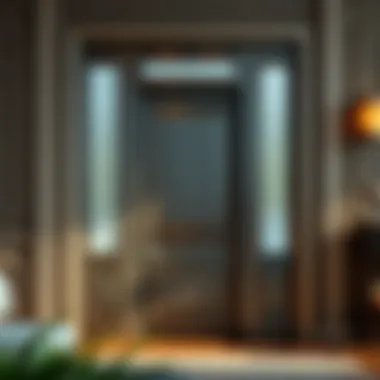
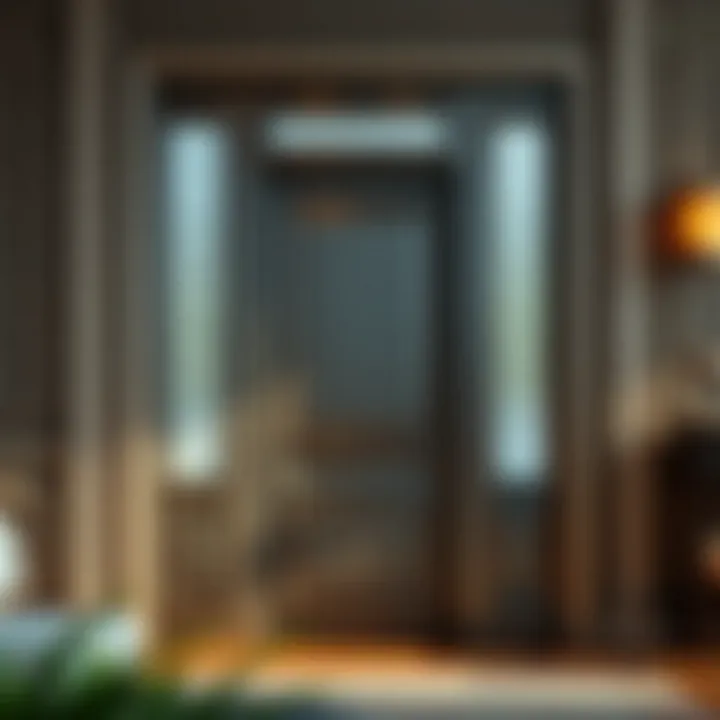
Intro
Steel doors have become an integral part of modern architecture, offering robustness alongside aesthetic appeal. Particularly, the 30 x 80 steel door is a popular choice among homeowners and designers alike. These doors are not simply a means of entry; they symbolize security, functionality, and style. When looking for durability, functionality, and attractive design, steel doors outshine the competition, making them a go-to option for various applications ranging from residential front doors to industrial entrances.
In this article, we'll explore what makes 30 x 80 steel doors special. We'll cover their notable features and the unique advantages they hold in different environments. From security benefits to energy efficiency, understanding the full scope of these doors will aid homeowners and professionals in making informed choices. You’ll find practical maintenance tips and recommendations that ensure longevity, because investing in a quality door shouldn’t end at the point of purchase; its maintenance is equally crucial.
With home security concerns on the rise, the choice of entryway is paramount. These steel doors are a sturdy solution, specifically designed to withstand wear and tear. From understanding contemporary design trends to identifying the right color palettes that suit the aesthetic of your space, this article aims to equip you with the knowledge needed to enhance both function and visual appeal of your property.
Key Points:
- Overview of the features of 30 x 80 steel doors
- Analysis of their applications in various settings
- Security, aesthetic, and functional advantages
- Detailed care and maintenance advice for longevity
- Latest trends in design and color that work well with steel doors
Let's delve deeper into the Furniture Trends that influence the market for steel doors and how they can reflect personal taste while meeting practical needs.
Prelims to Steel Doors
Steel doors stand at the forefront of modern construction and security. They embody a blend of durability, functionality, and aesthetic appeal, capturing the interest of homeowners, designers, and professionals alike. In an era where security is paramount, the choice of entrance can make a significant difference. Steel doors not only protect against intrusions but also enhance the overall value of a property.
Whether you're building a new home or renovating an existing space, understanding steel doors is crucial. Their robustness makes them a preferred choice for various applications, from residential fronts to industrial backdoors. Furthermore, steel doors have evolved in design, offering a wide range of options that cater to different architectural styles.
Definition and Characteristics
Steel doors are constructed mainly from steel sheets, with varying thicknesses that influence their strength and weight. Typically, they come with a core made from either polystyrene or polyurethane, which adds insulation and improves energy efficiency. Unlike wooden doors that might warp or swell with moisture, steel doors maintain their shape and performance in various weather conditions.
Main characteristics include:
- Durability: Can withstand heavy impacts and resist wear.
- Security: High resistance to forced entry.
- Versatility: Available in various designs, colors, and finishes.
- Low Maintenance: Rust-resistant coatings can be applied, reducing upkeep.
Typically used in environments where security is critical, steel doors have become synonymous with strength. Their ability to withstand fire ratings and other environmental factors is unmatched by other door materials.
Why Choose Steel Doors?
When it comes to choosing a door, the decision often revolves around security, aesthetics, and longevity. Steel doors excel in all these aspects, making them a worthy investment.
- Enhanced Security: The solid structure of steel doors provides exceptional protection against break-ins. For homeowners, this means peace of mind, knowing your family, and belongings are secure.
- Aesthetic Flexibility: Steel doors come in an array of designs, from sleek modern lines to more traditional motifs, integrating seamlessly with any architectural style. Homeowners can opt for custom finishes that complement their facade.
- Energy Efficiency: With better insulation properties compared to traditional doors, steel doors help keep indoor temperatures stable, leading to potential energy savings in heating and cooling costs.
- Cost-effective: While the initial investment might be higher than wood or fiberglass, steel doors offer long-term savings through their durability and energy efficiency. They do not require frequent replacements like some alternatives.
The advantages of steel doors make them a sound choice for discerning consumers focused on both security and aesthetics. With their strength and adaptability, they prove to be an intelligent option for various applications, ensuring they remain a staple in modern architecture.
Understanding x Dimensions
Understanding the dimensions of a steel door, specifically the 30 x 80 inches size, is crucial for anyone involved in design, renovation, or construction. This standard size is particularly favored due to its versatility and compatibility with various building styles. Not only does it dictate the structural integrity of the doorway, but it also influences the aesthetics and functionality of a space.
Standardization of Sizes
The concept of standardization in steel door dimensions helps to streamline manufacturing processes and installation practices. When a size like 30 x 80 is used widely, it supports an efficient supply chain that benefits manufacturers and consumers alike. This dimension is seen as a gold standard in both residential and commercial applications.
Using standard sizes can greatly reduce costs associated with custom designs. For example, when builders choose the standard 30 x 80 size, they often find doors readily available at competitive prices in local hardware stores. Additionally, this uniformity aids in replacement tasks, as homeowners can easily find a matching door when needed. In short, choosing a standardized door size can save time and money while ensuring consistency in design and function.
Application of x Steel Doors
Residential Use
30 x 80 steel doors are a go-to choice for residential spaces, blending durability with style. These doors typically come equipped with excellent security features, safeguarding homes from intrusions. The key characteristic that makes these doors particularly popular is their robust construction, which resists wear and tear over many years.
A unique benefit of using steel doors in homes is their resistance to the elements. Unlike wooden doors, steel doors do not warp or swell in response to humidity, making them less prone to damage in moist climates. This longevity enhances their appeal among homeowners, particularly those who prefer low-maintenance options.
Commercial Applications
In commercial settings, the need for secure and durable entryways is paramount. 30 x 80 steel doors meet this need excellently, often featuring enhanced security measures and fire-resistance ratings. They are a beneficial choice in various retail, office, and service environments where safety and accessibility are top priorities.
These doors can be customized to include glass inserts, allowing for visual appeal while securing the premises. However, their weight may pose a challenge during installation, requiring professional assistance. This downside is often outweighed by the long-term benefits they offer for business security and aesthetics.
Industrial Settings
When it comes to industrial settings, 30 x 80 steel doors shine due to their exceptional strength and ability to withstand high traffic. They are designed to endure the demands of warehouses, factories, and other heavy-use environments. The key characteristic of these doors here is their structural integrity, often reinforced to handle tools, machinery, and constant usage.
A unique feature of steel doors in industrial contexts is their fire resistance. Many are rated for fire safety, providing an additional layer of protection essential for workplaces that may involve hazardous materials. However, the installation may require specific considerations, such as fire-rated frames or specialized hardware.
Materials and Construction
Understanding the materials and construction of steel doors is crucial as it directly impacts durability, security, and maintenance. Relying on stronger components not only enhances the longevity of the door but also ensures you have a reliable entryway that withstands the test of time and the elements. Whether you're a homeowner looking for security or a designer aiming for aesthetic appeal, grasping these elements will help you make informed choices.
Types of Steel Used
When it comes to steel doors, the choice of material is like picking the foundation of a house. Different types of steel serve various purposes. For example, carbon steel is often favored for its strength. It’s nearly unyielding against external forces. An alternative is stainless steel, which not only offers brilliant resistance against corrosion but also maintains a polished look over time. You can expect to pay a bit more for stainless, but its longevity often justifies the bill.
- Carbon Steel: This type gives superior strength for structural needs. It's a tad less resistant to weather, so proper maintenance is a must.
- Stainless Steel: Comes with anti-rust properties and an aesthetic finish. It’s popular in environments where moisture is a concern.
Manufacturing Processes
The manufacturing process shapes the characteristics of the steel door you end up with. Let's break down the key processes:
Cold Rolled
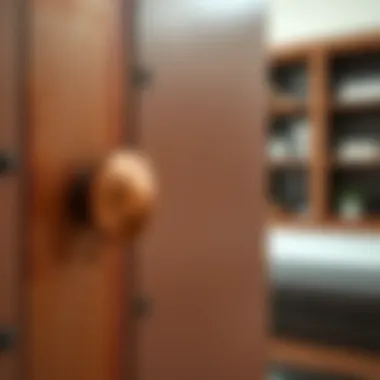
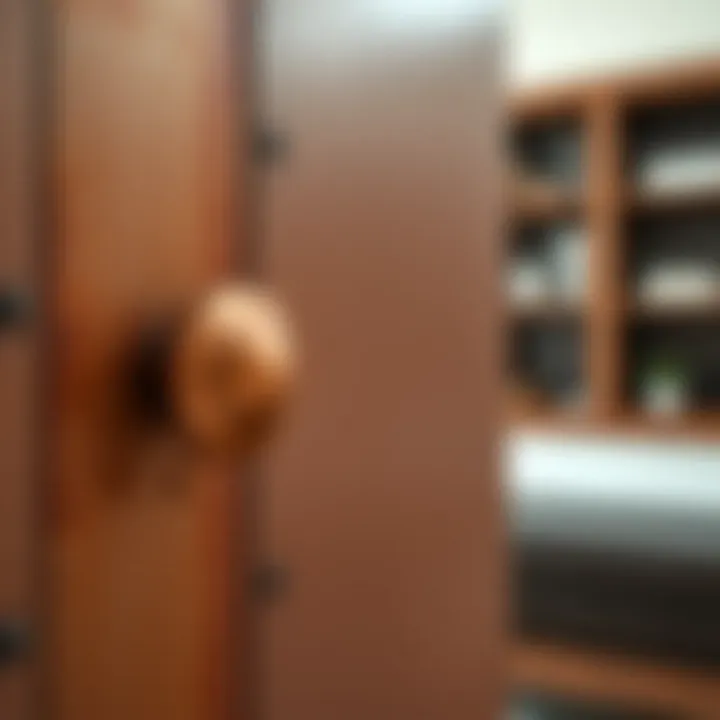
In cold rolling, steel is processed at room temperature. The benefits of this method include a finer finish and greater strength. It's often used when tight tolerances are needed, ensuring the door fits just right within its frame. A notable aspect of cold rolled steel is the surface finish; it tends to look smoother and more appealing right off the bat, which is a big deal for residential and commercial entrances alike.
- Unique Feature: Its tighter tolerances make it ideal for custom projects, where precision is key.
- Advantages: Easier to paint and resistant to most weather conditions. It also serves well in aesthetic applications, creating a sleek look.
Hot Rolled
Hot rolling is where the steel gets heated and shaped while hot. The end product is usually heavier, making it perfect for doors that need to endure heavy use, like in warehouses or industrial settings. The downside? It usually doesn’t have the same polished finish as cold rolled steel, and it may require extra maintenance to keep the rust at bay.
- Unique Feature: Hot rolled steel is also more malleable, allowing it to bend without breaking.
- Advantages: Stronger overall for structural applications, but the finish might call for a little extra care.
Galvanized Finishes
Galvanization adds a layer of protection that is hard to overlook. This process involves coating the steel with a layer of zinc, which wards off corrosion dramatically. It’s a smart choice if the door is exposed to weather or high humidity. The effectiveness of this finish can significantly extend the life of a door, making it a popular selection for external applications.
- Unique Feature: Effective in reducing maintenance needs over time, especially in harsher climates.
- Advantages: While it may raise the initial cost, its long-term benefits, such as reduced rusting and lower upkeep, make it a wise investment over time.
Understanding the right materials and manufacturing processes is fundamental for anyone considering steel doors, as it directly relates to both their performance and lifespan. The nuances between different types ensure you have a selection that suits your needs properly.
By paying close attention to these details in materials and construction, homeowners and builders alike can ensure that the steel doors they choose provide a perfect mix of security, style, and longevity.
Security Features of Steel Doors
When it comes to protecting a space, the security features of steel doors should not be underestimated. In today's world, safety is a paramount concern, whether for a home or a commercial establishment. Steel doors are often the first line of defense against potential intrusions or accidents. Their solid construction sets them apart, giving homeowners and businesses peace of mind not easily found with other door materials. Understanding these security features can help you see why steel doors are increasingly the go-to option in various settings.
Intrusion Resistance
Steel doors are known for their remarkable intrusion resistance. Unlike wooden or fiberglass doors, which can be easily compromised, steel doors boast a thickness that resists forced entry. When installed properly, they can withstand significant physical impacts, making it exceedingly difficult for anyone to break through.
Take, for instance, a typical residential area. If a steel door serves as the main entrance, intruders are much less likely to attempt a break-in compared to if the entrance is made of less durable materials. The very design of these doors, combined with robust locking mechanisms, ensures that even sophisticated methods of intrusion face substantial challenges.
In many instances, upgrading to a steel door can render a property far less appealing to thieves. Just the sight of a sturdy steel door can deter would-be burglars. This deterrent effect is not merely theoretical; numerous security studies have shown that homes with visibly solid security features experience fewer attempted break-ins than those without.
Fire Ratings and Safety
With increasing focus on fire safety, understanding the fire ratings and safety of steel doors is essential. Steel doors are uniquely suited for fire-resistive applications. Their ability to withstand high temperatures makes them valuable in both residential and commercial settings. When outfitted with fire-rated glass or integrated into fire-rated walls, these doors can provide vital minutes of protection during a blaze, giving occupants precious time to escape and aiding firefighters in their efforts.
Fire-rated steel doors are classified based on the amount of time they can withstand fire exposure, commonly rated for 20, 45, or even 90 minutes. This classification helps architects and builders select the ideal options suitable for various settings. The significance of this cannot be overstated; in places like hospitals, schools, or densely populated residential buildings, steel doors can be a critical component of an effective fire safety strategy.
Furthermore, fire-rated steel doors often come equipped with additional safety releases, allowing for automatic closure in the event of smoke or flame detection. This feature adds another layer of reliability to a structure's fire safety design.
"When it comes to fire safety, having a steel door could be the difference between life and death."
Aesthetic Variations
The world of steel doors is not solely about durability and security; aesthetics play a keystone role in their selection. Homeowners and designers alike recognize that an entryway significantly shapes the first impressions of a property. Aesthetic variations in steel doors not only enhance visual appeal but also embody the personality and character of a space. This discussion centers around how specific design elements contribute to both functionality and beauty, helping to bridge the gap between robust construction and artistic expression.
Design Options for Steel Doors
Textured Surfaces
Textured surfaces on steel doors can turn a mundane entry into striking focal points. Unlike polished finishes, which offer sleekness, textured surfaces invite touch and intrigue. Not only do they serve a purpose in hiding minor scratches and imperfections, but they also provide depth and character. This characteristic makes them a popular choice for residential homes looking to achieve a unique look without sacrificing strength. By offering raised or embossed designs, these doors often reflect light differently, adding a dynamic quality that can complement many architectural styles.
The advantage of textured doors lies in their ability to reduce the visibility of wear over time. However, a consideration remains: cleaning textured surfaces can be a little more involved compared to smoother finishes. Homeowners must keep in mind the need for maintenance to preserve the allure of these surfaces.
Color Finishes
Color finishes amplify the aesthetic versatility of steel doors. An array of hues allows for customization that can perfectly match or contrast with existing home themes. Deeper shades like navy or forest green add a touch of elegance and can evoke a strong presence, while lighter colors like soft beige or pastel tones can brighten a facade.
These finishes not only allow for broad creative freedom but also offer practical advantages. High-quality color finishes often include protective coatings that enhance resistance against UV rays and weathering, which is essential for maintaining vibrancy over time. However, one potential drawback might be the fading that some lesser quality finishes may experience with extended exposure to sunlight and elements, necessitating a periodic refresh.
Glass Inserts
The incorporation of glass inserts into steel doors introduces an airflow of elegance and sophistication. These inserts can be completely rectangular or artistically designed, similar to stained glass, allowing natural light to filter in while maintaining privacy. This element can transform a standard steel door into an architectural feature, providing a stylish and inviting entrance.
The key distinguishing attribute of glass inserts is their ability to create a seamless connection between indoor and outdoor environments. Particularly for homes with scenic views, these doors often serve as visual conduits, merging beauty with functionality. However, considerations around energy efficiency and visibility must not be neglected. Properly insulated glass can minimize heat loss, but unprotected or single-pane sections may lead to thermal inefficiency or compromise security.
Integration with Architectural Styles
Architecture reflects a dialogue between function and aesthetic; hence, how steel doors integrate into various styles furthers their importance. From contemporary minimalist designs to traditional brick homes, a well-chosen steel door enhances coherence in architectural themes. Moreover, aligning door designs with the overarching style transcends mere appearance—it harmonizes the dwelling, offering an inviting front that resonates with elegance.
- Modern Homes: Sleek lines and clear glass inserts align seamlessly.
- Victorian Residences: Traditional colors with textured surfaces can evoke nostalgia while providing modern durability.
- Industrial Spaces: Raw finishes and metallic color options integrate well with more rustic environments.
In essence, integrating aesthetic variations into the selection of steel doors is more than just a decorative choice—it's an opportunity to enhance the story and functionality of every space.
Installation Considerations
When contemplating the installation of a 30 x 80 steel door, it’s vital to take a focused look at some fundamental aspects. Installation isn’t merely about propping the door in position and hoping it fits correctly. There's a symphony of factors to consider. From choosing the right tools to ensuring that the door aligns perfectly within its frame, proper installation can mean the difference between functionality and frustrating inefficiencies.
Pre-Installation Preparations
Before the first screw is driven in, preparatory work is essential. This stage is often overlooked, yet it plays a pivotal role in the overall success of the installation. Here are some of the crucial steps you should consider:
- Space Assessment: Ensure that the door will fit in the designated space. Measure the rough opening where the door will be installed. This way, you can avoid any last-minute surprises.
- Tools Required: Gather all necessary tools. You’ll likely need a drill, screws, a level, and maybe even a mallet. Having your tools ready at hand avoids unnecessary interruptions once you begin.
- Weather Stripping and Insulation: Think about what will happen once the door goes in. Weather stripping is significant for maintaining efficiency. If you don’t prepare for this now, you may just find your cozy space feeling drafty later on.
- Verify Door Components: Check each part of the door system, ensuring that the hinges, locks, and other hardware are in good working order. If something seems off, it’s better to address it before the door is in place.
- Clear the Area: The installation zone should be tidy. Intrusive debris can be an impediment, causing interruptions during installation that could have otherwise been avoided.
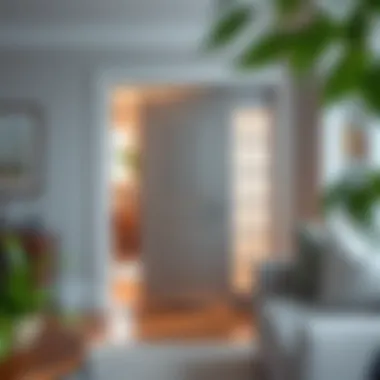
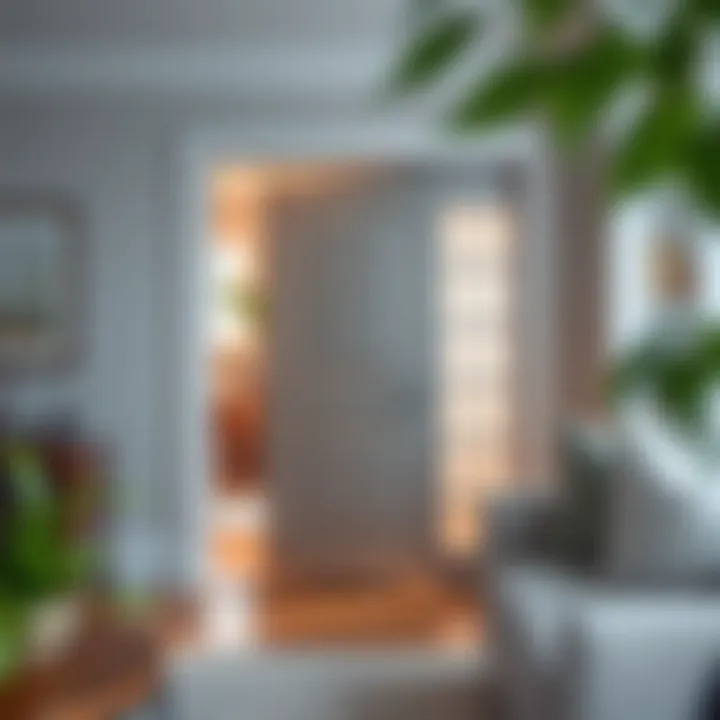
Professional versus DIY Installation
When deciding to go the DIY route or hire a professional, the pros and cons must be weighed carefully. Here is a breakdown of each approach:
Professional Installation
Choosing a professional can often mean peace of mind. Here are some reasons why you might consider tapping into expert services:
- Experience: Professionals are seasoned in the installation of various door types, enabling them to handle unexpected challenges with ease.
- Time Efficient: What might take an inexperienced person hours, a professional could accomplish in a fraction of that time.
- Warranty Considerations: Many manufacturers require professional installation to uphold warranty protections. This can be a critical factor when considering the long-term value of your door.
DIY Installation
Opting for a do-it-yourself installation can be rewarding, but it is not without its challenges. Here are some aspects to note:
- Cost Savings: By going the DIY route, you can save on labor costs, which can often be substantial in the world of construction and installation.
- Control Over the Process: You’ll manage every stage of the installation, ensuring that it meets your standards.
- Learning Opportunity: Installing a steel door can provide valuable hands-on experience, a skill that might come in handy for future projects.
However, this should not be taken lightly; ensure that you have the necessary skills. Misalignments or improperly secured doors can lead to security risks and longevity issues.
"The difference between a successful installation and a frustrating experience often lies in the details."
By weighing the complexities of professional versus DIY installation thoroughly and preparing adequately, you’re setting the stage for a successful installation of your 30 x 80 steel door. Ultimately, the choice depends on your level of expertise, time availability, and willingness to engage in possibly challenging tasks.
Maintenance and Care
Maintaining and caring for steel doors is a crucial aspect that shouldn't be overlooked. A steel door is not merely an entryway; it is a sturdy barrier against unwanted intrusions, extreme weather conditions, and the test of time. Proper care not only enhances longevity but ensures optimal performance in all conditions. From rust prevention to ensuring aesthetic appeal, the focus on maintenance can save homeowners and professionals alike from costly repairs or replacements in the long run.
Regular Maintenance Practices
Regular maintenance isn’t a chore; it’s a way to ensure that your steel door remains functional and visually appealing throughout its lifespan. Simple tasks can make a world of difference. Here are some best practices:
- Clean the Surface: Use a mild detergent mixed with water to wash the door periodically. It's a good idea to scrub any dirt, dust, or debris that may have built up. This practice not only keeps the door looking fresh but also prevents corrosion.
- Inspect for Damage: Regularly checking for dents, scratches, or rust spots can help in addressing issues before they escalate. A little attention can go a long way. If you notice rust, addressing it promptly with sandpaper and paint can prevent further deterioration.
- Lubricate Moving Parts: Hinges and locks require lubrication to function smoothly. A silicone spray or a graphite lubricant works wonders. This will keep the door operating freely and avoid wear and tear that comes from friction.
- Touch Up Paint When Needed: Any scratches in the paint can expose the steel to moisture and lead to rust. Keep some touch-up paint handy to fill in nicks and maintain a seamless appearance.
These practices take little time and effort but will extend the life of your steel door significantly.
Long-Term Care Strategies
While regular maintenance keeps your steel door in shape day to day, long-term care strategies ensure it stands the test of time. Here are some essential considerations:
- Proper Sealing: It’s vital to check the seals around your door. Weather stripping ensures that air leaks are minimized, which is essential in maintaining energy efficiency. Proper sealing can significantly reduce heating and cooling costs over time.
- Professional Inspection: Every few years, consider hiring a professional to assess the door’s condition comprehensively. They can offer insights that might not be obvious and recommend treatment plans or repairs that can help extend its lifespan.
- Invest in Quality Paint: Coating the door with high-quality paint designed to withstand the elements is a worthwhile investment. Not only does this enhance the door’s appearance, but it also serves as a protective layer.
- Address Environmental Elements: If your door is exposed to harsh weather conditions, such as heavy rainfall or high humidity, consider additional protective measures. This can include installing awnings or using high-performance coatings that resist corrosion.
In summary, maintenance and care for steel doors encompass not only routine checks and cleaning but also proactive approaches to longevity. By incorporating these strategies, one can enjoy the robustness of a steel door for years while ensuring it remains as striking as the day it was installed.
Proper upkeep of a steel door not only protects your investment but enhances your property’s overall aesthetic value.
Comparative Analysis
In the quest for optimal entryways, a careful comparative analysis can make all the difference. When considering steel doors, especially in the 30 x 80 size, it's essential to weigh their features against alternatives like wood and fiberglass doors. Such comparisons not only spotlight the strengths and weaknesses of each option but also guide homeowners, designers, and DIY enthusiasts to make informed choices that cater to their specific needs. Evaluating factors such as durability, security, maintenance, and aesthetics is critical in this decision-making process.
Steel Doors vs. Wood Doors
When putting steel doors head-to-head with wood doors, several critical factors emerge. Durability takes center stage; steel is known for its incredible resilience against wear and tear. Unlike wood, which may splinter, warp, or decay over time—especially under harsh weather conditions—steel doors hold their ground firmly. This durability not only enhances security but also lowers the frequency of repairs, ultimately saving homeowners money in the long run.
Moreover, steel doors offer superior security features. They tend to have higher resistance to forced entry, whereas wood doors, while aesthetically pleasing, often succumb to vulnerabilities that can be exploited by intruders. That said, wood has its own charm, providing a warm, classic look which some homeowners might desire for aesthetic purposes.
However, it’s crucial to note that
- Price Point: Wood doors may seem cheaper initially, but the long-term cost associated with maintenance can make steel a more economical choice over time.
- Insulation: Steel may require insulation, which can be an added expense, but its energy efficiency is on par with well-insulated wood doors.
"In the end, it’s about balancing aesthetics with practical needs."
Steel Doors vs. Fiberglass Doors
Comparing steel doors to fiberglass doors brings different elements into play. Fiberglass is light and can mimic the look of wood while providing durability. However, it still lacks the strong security profile of steel. Steel doors are less prone to damage and can effortlessly withstand the elements, including hail and high winds.
Also, consider maintenance—fiberglass doors may need repainting over time to maintain appearance, while steel doors can be maintained simply with occasional touch-ups or protective finishes.
On the other hand, fiberglass doors offer excellent insulation properties and typically do not expand or contract with temperature changes, unlike steel. This feature could be crucial in regions with extreme weather, making them less susceptible to thermal warpage.
Here are key points to consider:
- Cost: Fiberglass doors can be pricey up front but often come with warranties that can save money over time.
- Customization: Both materials can be customized in terms of styles and finishes, but fiberglass often has more variance in appearance options, mimicking wood grains and other textures.
Regulatory Standards and Compliance
When dealing with steel doors, especially the widely utilized dimensions of 30 x 80, regulatory standards and compliance become crucial for multiple reasons. These standards provide a framework that ensures safety, security, and efficiency in structures ranging from homes to commercial buildings. As a homeowner, designer, or contractor, understanding these guidelines isn't just beneficial—it's essential for ensuring a reliable and lawful installation.
Industry Standards
Various organizations and committees set forth industry standards for steel doors, establishing criteria that define quality, security, and performance. One of the most recognized entities is the American National Standards Institute (ANSI), which, alongside the National Institute of Standards and Technology (NIST), provides comprehensive guidelines for production and testing of steel doors. Compliance with these standards guarantees that steel doors undergo rigorous assessment, making them resilient against various hazards.
Furthermore, organizations like Underwriters Laboratories (UL) offer evaluations related to fire ratings and security levels, ensuring the doors can withstand specific conditions. Notably, a UL-listed steel door offers confidence to buyers, knowing that the product has passed rigorous testing for durability and safety.
Here are some vital aspects covered by industry standards for steel doors:
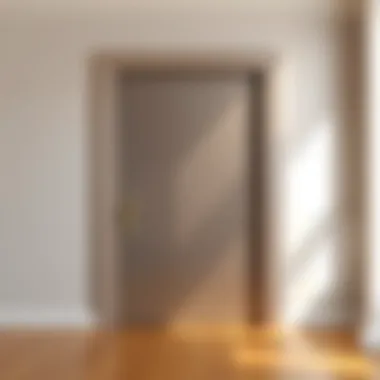
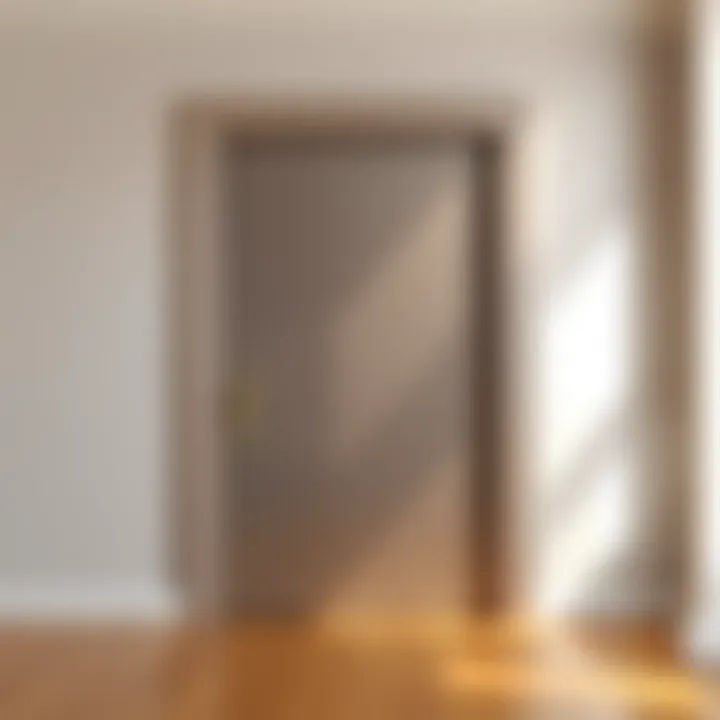
- Resistance to Forced Entry: Certifying that the door can withstand specific levels of force.
- Fire Resistance Ratings: Ensuring the door meets safety regulations regarding fire hazards.
- Thermal Performance: Evaluating how well the door can insulate against temperature changes, thus saving energy.
Local Building Codes
Local building codes are another layer of regulations that govern the installation and performance of steel doors. These codes vary widely from one jurisdiction to another, and it's critical for stakeholders to familiarize themselves with the specific requirements in their area. Local codes dictate everything from the minimum size and strength requirements to the specific types of locks and hardware permitted.
In many municipalities, building codes also address accessibility standards, ensuring compliance with the Americans with Disabilities Act (ADA). This means that a 30 x 80 steel door in a commercial setting must not only be sturdy but also easy to use for all individuals, regardless of physical limitations.
It’s worth noting an important point:
Neglecting local building codes can lead to costly fines and required renovations.
Upon inspection, if a door does not meet these codes, adjustments or replacements might be necessary, drastically increasing overall project costs.
Additionally, certain localities require detailed documentation and permits before installation. Aligning with these standards not only facilitates a smoother permitting process but also enhances the overall durability and safety of the door once installed.
In summary, for homeowners, designers, and DIYers, understanding the regulatory standards and local building codes surrounding steel doors is crucial. They ensure that the doors are built to last, comply with safety regulations, and meet the aesthetic needs of the space. Ignoring these factors can lead to issues down the line, making thorough research and adherence non-negotiable.
Sustainability Aspects
The conversation around sustainability is no longer just a passing fad. In today’s world, it’s essential for industries to focus on environmentally friendly practices, and the steel door industry is no exception. Steel doors, specifically the 30 x 80 variety, are gaining traction as a sustainable choice for construction and renovation projects. Let’s take a closer look at a few vital dimensions of sustainability in steel doors, particularly recyclability and energy efficiency considerations.
Recyclability of Steel
Steel is known for its robust nature, and when it comes to sustainability, this characteristic shines even brighter. One of the standout features of steel doors is their recyclability. Unlike wood or plastic, steel can be melted down and reused without losing integrity. Approximately 90% of steel can be recycled.
- Lifecycle Impact: When a 30 x 80 steel door reaches the end of its life, it doesn’t just go to waste. Steel is a material that can end up as a part of new products or structures. This recycles benefits not just the environment, but also contributes to the local economy by reducing materials costs in construction.
- Manufacturing Processes: Steel production has evolved, with many manufacturers now using recycled steel as a primary input. This not only decreases the reliance on new raw materials but also cuts down on energy consumption and emissions during production.
"Recycling steel saves enough energy to power 18 million homes for a year" - National Recycling Coalition.
This incredible fact underscores how steel doors are touching on energy sustainability as well. Homeowners and businesses opting for steel doors can feel confident about making a greener choice.
Energy Efficiency Considerations
Another significant aspect of sustainability relates to the energy efficiency of steel doors. Understanding this can help homeowners, designers, and builders make choices that benefit both the environment and their wallets.
- Insulation Properties: Many 30 x 80 steel doors come equipped with insulation technology that helps keep spaces warm in winter and cool in summer. This reduces reliance on heating and cooling systems, resulting in lower energy bills.
- Long-term Durability: Steel doors tend to hold up better against wear and tear compared to other materials. This durability means they need less maintenance over time, and fewer replacements are necessary. Each replacement generally comes with a significant environmental cost, so longevity plays a critical role in overall sustainability.
- Reflective Finishes: Some manufacturers offer reflective coatings for steel doors, enhancing their ability to deflect sunlight. This leads to a cooler interior environment, particularly in hot climates, and further strips down energy consumption from air conditioning systems.
Ultimately, the choice of 30 x 80 steel doors aligns closely with implementing sustainable practices and reducing ecological footprints. Homeowners and builders can consider these aspects when making decisions about their entryways, ensuring not just beauty and security, but also a responsibility toward the environment.
Cost Analysis
In any construction or renovation project, understanding costs is vital. This section on cost analysis delves into the financial landscape surrounding 30 x 80 steel doors. It offers insights into not just the initial price tags but also what the long-term investment looks like. For homeowners, designers, and industry agents, discerning between upfront expenses and ongoing value is crucial for making informed decisions.
Initial Cost Considerations
When contemplating the purchase of a 30 x 80 steel door, the first thought often leans toward the initial cost. What’s displayed on the price tag plays a pivotal role in decision-making. Here are several factors to weigh:
- Material Quality: The type of steel and the door's thickness profoundly influence cost. Economical options might catch the eye, but durability should not be overlooked.
- Design Features: Custom designs with intricate patterns or additional functionalities, like built-in window frames or unique color finishes, can quickly inflate expenses.
- Installation Fees: Hiring professionals typically incurs additional labor costs. This fee varies based on geographical location and the complexity of the installation.
These elements together formulate the overall initial investment, which, while significant, should not overshadow other considerations.
Long-Term Value Assessment
After the initial cost is settled, the focus should pivot toward the long-term value of investing in steel doors. While they might ask for more upfront cash, the durability and lifespan generally justify the expense. Consider the following:
- Longevity: Steel doors boast impressive durability, usually lasting decades without serious wear. This lifespan translates directly to cost savings over time.
- Energy Efficiency: Many steel doors are designed to be energy-efficient. A door that minimizes energy loss can decrease utility bills significantly, making it a wise investment over time.
- Low Maintenance: Unlike wood, which may require painting and sealing, steel typically needs minimal upkeep. This economy of maintenance impacts overall long-term costs.
- Resale Value: In terms of property investment, quality steel doors can enhance the value of a home. They are often seen as attractive features by potential buyers.
"When evaluating the worth of a product, never underestimate the importance of what it can save you in the long run."
Future Trends in Steel Door Design
The landscape of steel door design is continually transforming, much like the air around a fresh snowfall. As technology leaps forward and consumer preferences shift, various trends are beginning to surface, reflecting the changing needs and desires of homeowners, designers, and companies alike. Staying ahead of these trends is not just about aesthetics; it’s about ensuring security, energy efficiency, and sustainability in an often unpredictable world. Understanding these trends is crucial for anyone looking to make informed choices around steel doors, setting the stage for contemporary installations that merge style with functionality.
Innovations in Materials
When it comes to material choices, the steel door industry is making serious strides that are redefining what we think about durability and style. Gone are the days when steel meant industrial or utilitarian. Modern steel doors now incorporate composite materials and premium coatings that not only enhance their strength but also provide energy-efficient insulation properties.
- Composite Core: Utilizing a composite core inside a steel door can improve insulation while reducing weight. This advancement not only fortifies the door against breaches but also enhances thermal efficiency, making it a smart investment in any climate.
- Eco-Friendly Coatings: In alignment with global sustainability efforts, many manufacturers are working on eco-friendly, low-VOC coatings that minimize environmental impact while maintaining aesthetic appeal. These finishes are also designed to resist fading and corrosion, ensuring that the door looks great even after years of weather exposure.
- Color and Textures: Advancements in manufacturing processes allow for a wider range of color options and textures that don't compromise the door’s integrity. Steel can be textured to give it a more wood-like appearance or painted in vibrant colors to complement a home’s exterior.
"The materials we choose for our doors not only tell a story but also impact usability and energy savings for years to come."
Technological Advancements
Technology is revolutionizing many aspects of our lives, and steel doors are no exception. Innovations in technology are making these doors smarter, enhancing both security and convenience.
- Smart Lock Integration: Many steel doors now come with integrated smart lock systems. These advanced locks provide remote access controls that can sync with your smartphone, allowing homeowners to monitor who comes and goes at their convenience. This could mean the difference between feeling secure or vulnerable when you're away.
- Enhanced Security Features: Beyond standard locks, some steel doors now incorporate biometric systems. These sophisticated locks can only be opened with a fingerprint, adding an extra layer of security that traditional locks can't match. As a result, you're not just safeguarding your belongings – you're also investing in peace of mind.
- Energy Monitoring: Some new designs even feature sensors that can monitor the temperature inside, alerting homeowners via an app if there are changes that may indicate drafts or inefficiencies, thus promoting better energy use.
- Automated Maintenance Alerts: Imagine receiving a notification that reminds you of when to inspect your door for any wear or tear. This tech-savvy feature assists both homeowners and professionals, making management simple and effective.
In the grand scheme of doors, staying updated on these future trends is vital for those looking to incorporate steel doors into their spaces. Innovations in materials and technology not only present new opportunities for style but also provide practical benefits that cater to the modern lifestyle. As the industry continues to evolve, embracing these changes will lead to installations that are as durable as they are attractive. This dynamic interplay of form and function makes the future of steel doors bright and promising.
Ending
In wrapping up our exploration of 30 x 80 steel doors, it is clear that these entryways offer more than mere functionality. The significance of integrating steel doors into various spaces, whether residential, commercial or industrial, hinges on their durability and security features. The capacity of steel doors to withstand wear and tear, paired with their aesthetic versatility, offers a compelling combination for those looking to make a well-informed decision.
Steel doors present a number of advantages: they are built to last, offering a level of resistance to both physical intrusion and natural elements. Their fire ratings and safety standards add an important layer of security, ensuring peace of mind for homeowners and business operators alike. Furthermore, the variety of aesthetic options allows steel doors to be an attractive fit for different architectural styles, contributing to overall curb appeal.
When considering installation and long-term maintenance, understanding the requirements can help mitigate common issues. Proper upkeep not only enhances the lifespan of a door but also preserves its appearance and functionality, making it a wise investment. Thus, our discussion leads to a realization that choosing the right door involves looking beyond initial costs to weigh the long-term benefits.
"Investing in steel doors is not just about enhancing security; it's about ensuring a lasting solution that merges form with function."
Looking ahead, it's evident that steel doors will continue to evolve, incorporating new technologies and design trends to better serve their purpose in modern architecture. As such, keeping abreast of these developments will further empower homeowners, designers, and professionals in making educated selections.















